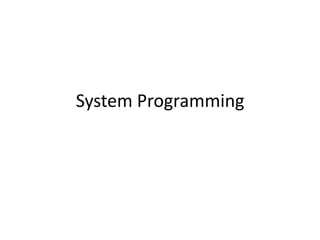System programming involves designing and implementing system programs that assist in the execution of general user programs. This includes operating systems, compilers, assemblers, linkers, and debuggers. The document discusses what system and programming are, types of software, system programs, and components of system programming like interpreters, assemblers, compilers, macros, and operating systems. It also explains the functions of operating systems and types of translators like assemblers, compilers, cross assemblers, cross compilers, and interpreters. Loaders, macro processors, linking, and formal systems are also defined. Finally, the document discusses two-pass assemblers, specifying the problem, data structures, and general design procedure.

























![General Design Procedure of Two Pass
Assembler
1. Specify the problem
2. Specify data structures
3. Define format of data structures
4. Specify algorithm
5. Look for modularity [capability of one
program to be subdivided into independent
programming units.]
6. Repeat 1 through 5 on modules.](https://image.slidesharecdn.com/unit1-111206003944-phpapp02-150714045953-lva1-app6892/85/Unit1-111206003944-phpapp02-26-320.jpg)

![Specify the problem
Pass1: Define symbols & literals.
1) Determine length of m/c instruction [MOTGET1]
2) Keep track of Location Counter [LC]
3) Remember values of symbols [STSTO]
4) Process some pseudo ops[EQU,DS etc] [POTGET1]
5) Remember Literals [LITSTO]](https://image.slidesharecdn.com/unit1-111206003944-phpapp02-150714045953-lva1-app6892/85/Unit1-111206003944-phpapp02-28-320.jpg)
![Pass2: Generate object program
1) Look up value of symbols [STGET]
2) Generate instruction [MOTGET2]
3) Generate data (for DS, DC & literals)
4) Process pseudo ops[POTGET2]](https://image.slidesharecdn.com/unit1-111206003944-phpapp02-150714045953-lva1-app6892/85/Unit1-111206003944-phpapp02-29-320.jpg)
![Step 2. Data structure:-
Pass1: Databases
• Input source program
• “LC” location counter used to keep track of each
instructions addr.
• M/c operation table (MOT) [Symbolic mnemonic & length]
• Pseudo operation table [POT], [Symbolic mnemonic &
action]
• Symbol Table (ST) to store each lable & it’s value.
• Literal Table (LT), to store each literal (variable) & it’s
location.
• Copy of input to used later by PASS-2.](https://image.slidesharecdn.com/unit1-111206003944-phpapp02-150714045953-lva1-app6892/85/Unit1-111206003944-phpapp02-30-320.jpg)
![Step 2. Data structure:-
• Pass2: Databases
• Copy of source program input to Pass1.
• Location Counter (LC)
• MOT [Mnemonic, length, binary m/c op code, etc.]
• POT [Mnemonic & action to be taken in Pass2
• ST [prepared by Pass1, label & value]
• Base Table [or register table] indicates which registers
are currently specified using ‘USING’ pseudo op & what
are contents.
• Literal table prepared by Pass1. [Lit name & value].](https://image.slidesharecdn.com/unit1-111206003944-phpapp02-150714045953-lva1-app6892/85/Unit1-111206003944-phpapp02-31-320.jpg)









![Machine Dependent and Machine
Independent features of Assembler
• M/C Dependent Features
– A] Instruction format & addr. mode:-
– B] Program Relocation
• Machine Independent Assembler Features
– 1) Literals
– 2) Symbol defining statements
– 3) Expressions](https://image.slidesharecdn.com/unit1-111206003944-phpapp02-150714045953-lva1-app6892/85/Unit1-111206003944-phpapp02-41-320.jpg)